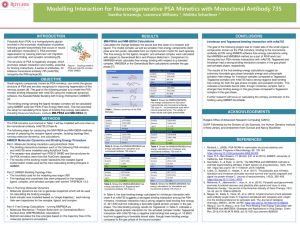Sriramoju, Swetha: Modelling Interaction for Neuroregenerative PSA Mimetics with Monoclonal Antibody 735
Title: Modelling Interaction for Neuroregenerative PSA Mimetics with Monoclonal Antibody 735
Name: Swetha Sriramoju
Major: Biological Sciences
School affiliation: School of Arts and Sciences
Programs: Division of Life Sciences Summer Undergraduate Research Fellowship (DLS-SURF)
Other contributors: Lawrence Williams and Melitta Schachner
Abstract: Polysialic Acid (PSA) is a homopolymeric glycan involved in neural cell regeneration among the central nervous system. it is involved in tissue repair and regeneration. The PSA mimetics are recognized as small organic molecules that function and “mimic” PSA binding interactions with receptors for instance the monoclonal antibody 735. The goal of the following project is to model the PSA mimetic binding interaction with the monoclonal antibody 735 using the molecular dynamics software, The Assisted Model Building with Energy Refinement (AMBER). This tool provides the setup for calculating three types of binding free energy calculations, including MM-PBSA and MM-GBSA methods. For conducting the binding simulations in amber, The PSA mimetics modelled are: Idarubicin, Irinotecan, Epirubicin hydrochloride, Tegaserod, and Vinorelbine. Each mimetic will be modelled with one chain of the monoclonal antibody 735 (Chain A). Modelling the mimetic interaction with monoclonal antibody 735 consists of four main components with respect to preparing the receptor-ligand complex, building topology files, running molecular dynamics, and calculations. Tegaserod interaction has a negative total binding free energy of -10.95 kcal/mol suggesting a favorable bound state, though lower binding energy compared to the gas phase of the bound complex. The results of the free binding energy calculations suggest an extremely favorable gas phase favorable energy and unfavorable solvation free energy for Irinotecan complex compared to Tegaserod. Tegaserod complex had a strong negative total binding free energy for both the gas phase complex and solvated complex. This indicates a favorable bound state, though Irinotecan complex had a stronger free binding energy in the gas phase compared to Tegaserod complex in the gas phase.
